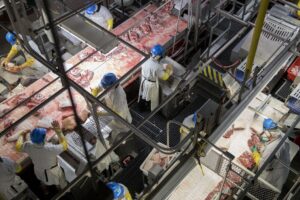
Light at the End of the Tunnel? Possibility for Pork Producers in 2025
After years of challenging market conditions, pork producers may finally see a glimmer of hope on the horizon.The economic landscape for hog farmers has been brutally tough since 2020, with pandemic disruptions, labor shortages, and fluctuating feed prices creating a perfect storm of challenges.
But 2025 could mark a turning point. According to recent industry forecasts, a combination of reduced production costs and growing export opportunities may finally deliver some much-needed profitability to the sector. Market analysts are projecting a 7.8% increase in pork exports compared to 2023 levels, with especially strong demand from markets in Southeast Asia and Mexico.
Feed costs, which represent approximately 65-70% of total production expenses, are expected to decline by 12% to 14.5% as corn and soybean harvests normalize after recent disruptions. This alone could boost producer margins by $18-$23 per head.
And yet skepticism remains. Haven’t we heard these optimistic projections before?
Industry veteran Thomas Hargrove puts it bluntly: “I’ve been hearing about ‘recovery just around the corner’ for three straight years now. What’s different this time is we’re seeing actual structural changes in the supply chain, not just wishful thinking. Producers who’ve managed to hang on this long might actually see daylight in 2025.”
The data supports this cautious optimism. Hog inventory numbers released last quarter show a 3.2% decline in breeding stock nationwide, indicating that supply should tighten by mid-2025. Meanwhile, Domestic pork consumption has remained surprisingly resilient despite inflation pressures, hovering around 51.4 pounds per capita.
But structural challenges persist within the industry. Processing capacity limitations continue to bottleneck potential growth in certain regions.Labor shortages—particularly acute in rural areas—remain a notable concern for both producers and processors. Immigration policies and workforce development will play crucial roles in determining whether the sector can fully capitalize on improved market conditions.
A more balanced supply and demand equation doesn’t guarantee success for all operations. Those carrying excessive debt loads from the past three years of losses may still struggle to recover.
The Environmental Protection Agency’s new CAFO (Concentrated Animal Feeding Operation) regulations also loom large over the industry. Compliance costs could offset some of the anticipated gains, particularly for smaller producers without economies of scale. Approximately 37% of operations may need significant infrastructure upgrades to meet these requirements.
For those positioned to weather these challenges, international markets offer significant opportunity. China’s pork industry continues to rebuild after African Swine Fever devastated their herds, but their import needs remain above historical averages.
And the recently announced trade framework with Vietnam could open additional export channels. Economists estimate this could add $4.50-5.75 per head to producer returns.
Will these promising developments finally deliver sustained profitability? That depends largely on factors beyond producers’ control—weather patterns affecting feed production, geopolitical tensions, and macroeconomic trends all influencing the ultimate outcome.
Smart producers are cautiously planning for improved conditions while maintaining financial adaptability. Industry consolidation will likely continue, but perhaps at a slower pace than the past 36 months.




